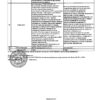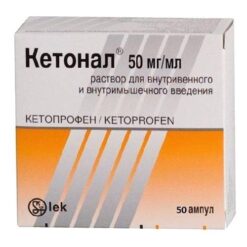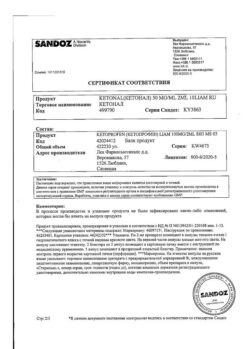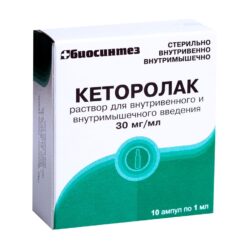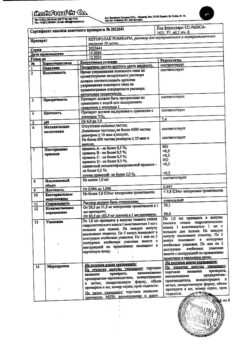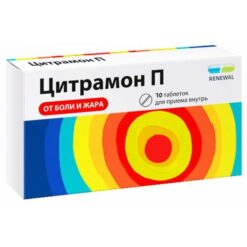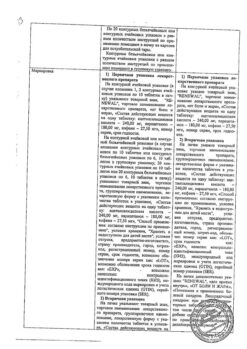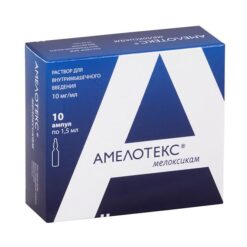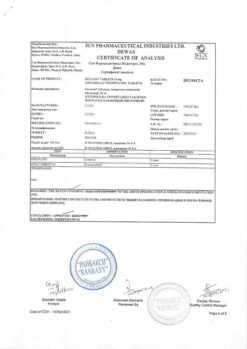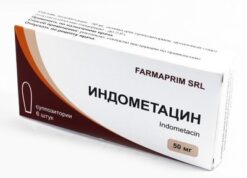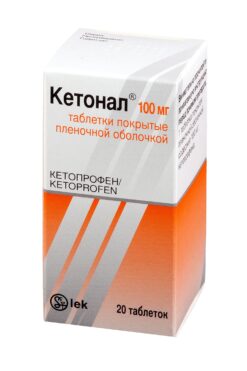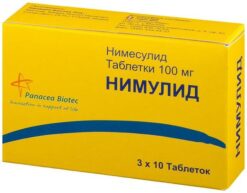No products in the cart.
Diclofenac-FPO, 50 mg 20 pcs
€1.00
Out of stock
(E-mail when Stock is available)
Description
Non-steroidal anti-inflammatory drug, derivative of phenylacetic acid; has anti-inflammatory, analgesic and antipyretic effects. By indiscriminate inhibiting cycloxygenase 1 and cycloxygenase 2 it disrupts arachidonic acid metabolism, decreases quantity of prostaglandins in inflammation focus.
It is most effective for pain of inflammatory nature. Like all non-steroidal anti-inflammatory drugs, the drug has an anti-aggregant effect.
Indications
Indications
Joint syndrome (rheumatoid arthritis, osteoarthritis, ankylosing spondylitis, gout), degenerative and chronic inflammatory diseases of the musculoskeletal system (osteochondrosis, osteoarthritis, periarthropathy), post-traumatic inflammation of soft tissue and musculoskeletal system (sprains, bruises).
Pain in the spine, neuralgia, myalgia, arthralgia, pain and inflammation after surgery and trauma, painful syndrome with gout, migraine, algodysmenorrhea, painful syndrome with adnexitis, proctitis, colic (biliary and renal), painful syndrome with inflammatory diseases of the ENT.
For local use: inhibition of miosis during cataract surgery, prevention of cystoid macular edema associated with removal and implantation of the lens, ocular inflammation of non-infectious nature, post-traumatic inflammatory process with penetrating and non-penetrating wounds of the eyeball.
Active ingredient
Active ingredient
Composition
Composition
Active substance:
diclofenac sodium – 50 mg.
Auxiliary substances:
colloidal silica (aerosil),
potato starch,
crospovidone,
calcium stearate,
cellulose microcrystalline.
Shell excipients:
Methacrylic acid and ethyl acrylate copolymer (Collicut MAE P100), povidone (Collidon 30), iron oxide brown, propylene glycol, talc, titanium dioxide, hydroxypropyl methylcellulose (hypromellose).
How to take, the dosage
How to take, the dosage
Overly, without chewing, during or after a meal, with a small amount of water. Adults and adolescents from 15 years of age – 25-50 mg 2-3 times a day.
When optimal therapeutic effect is achieved, the dose is gradually reduced and maintenance treatment is switched to a dose of 50 mg/day. The maximum daily dose is 150 mg.
For children over 6 years of age and adolescents, 25 mg tablets are used; the daily dose is 2 mg/kg body weight of the child, divided into 2-3 doses. In juvenile rheumatoid arthritis, the daily dose may be increased to 3 mg/kg body weight. Tablets should be taken whole, without chewing, on an empty stomach, with a small amount of liquid.
Interaction
Interaction
When concomitant use with diclofenac of antihypertensive drugs may weaken their effect.
There have been single reports of seizures in patients who have concomitantly taken NSAIDs and antibacterial quinolones.
The risk of digestive side effects increases with concomitant use of GCS.
Concomitant use of diuretics may decrease the diuretic effect. Concomitant use with potassium-saving diuretics may increase the blood potassium concentration.
Concomitant use with other NSAIDs may increase the risk of side effects.
There have been reports of hypoglycemia or hyperglycemia in patients with diabetes mellitus who have used diclofenac concomitantly with hypoglycemic medications.
Concomitant use with acetylsalicylic acid may decrease the plasma concentration of diclofenac.
While in clinical trials it has not been established the effect of diclofenac on the effect of anticoagulants, there have been individual cases of bleeding when concomitant use of diclofenac and warfarin.
Concomitant use may increase plasma concentrations of digoxin, lithium and phenytoin.
Gastrointestinal absorption of diclofenac is decreased with concomitant use with colestiramine, and to a lesser extent with colestipol.
Concomitant use may increase plasma concentrations of methotrexate and increase its toxicity.
Concomitant use of diclofenac may not affect the bioavailability of morphine, but the concentration of the active metabolite of morphine may remain elevated in the presence of diclofenac, which increases the risk of side effects of morphine metabolite, including respiratory depression.
In concomitant use with pentazocine a case of large convulsive seizure has been described; with rifampicin – possible decrease of concentration of diclofenac in plasma; with ceftriaxone – excretion of ceftriaxone with bile increases; with cyclosporine – possible increase of nephrotoxicity of cyclosporine.
Special Instructions
Special Instructions
With special caution use in patients with a history of liver, kidney and gastrointestinal disorders, dyspeptic complaints, bronchial asthma, arterial hypertension, heart failure, immediately after major surgical interventions, as well as in elderly patients.
With indications in the anamnesis of allergic reactions to NSAIDs and sulfites diclofenac is used only in urgent cases. During treatment systematic control of liver and kidney function and peripheral blood count is necessary.
The rectal administration is not recommended in patients with anorectal diseases or anorectal bleeding in the history. Externally, only use on intact areas of skin.
Contact with diclofenac in the eyes (except in eye drops) or on the mucous membranes should be avoided. Patients who use contact lenses should not use eye drops until 5 minutes after removing the lenses.
The use in children under 6 years of age is not recommended.
The consumption of alcohol is not recommended during treatment with dosage forms for systemic use.
Impact on the ability to drive and operate machinery
During treatment, there may be a decrease in the speed of psychomotor reactions. If clarity of vision deteriorates after the use of eye drops, do not drive or engage in other potentially dangerous activities.
Contraindications
Contraindications
With caution:
. Anemia, bronchial asthma, cerebrovascular disease, coronary heart disease, congestive heart failure, arterial hypertension, peripheral artery disease, edema syndrome, hepatic or renal failure, dyslipidemia/hyperlipidemia, diabetes mellitus, smoking, inflammatory bowel disease, conditions after major surgical interventions, inducible porphyria, advanced age, diverticulitis, systemic connective tissue disease, I-II trimester pregnancy, creatinine clearance less than 60 ml/min.
Side effects
Side effects
Gastrointestinal system: nausea, vomiting, anorexia, pain and discomfort in epigastric region, flatulence, constipation, diarrhea; in some cases – erosive ulcerative lesions, bleeding and perforations of the gastrointestinal tract; rarely – liver function disorders. In rectal administration in single cases there have been cases of inflammation of the colon with bleeding, exacerbation of ulcerative colitis.
CNS and peripheral nervous system disorders: dizziness, headache, agitation, insomnia, irritability, fatigue; rarely – paresthesia, visual disturbances (blurring, diplopia), tinnitus, sleep disorders, seizures, irritability, tremor, mental disorders, depression.
With the hematopoietic system: rarely – anemia, leukopenia, thrombocytopenia, agranulocytosis.
Additional disorders of the urinary system: rarely – renal dysfunction; edema is possible in predisposed patients.
Dermatological reactions: rarely – hair loss.
Allergic reactions: skin rash, itching; when used in the form of eye drops – itching, redness, photosensitization.
Overdose
Overdose
Symptoms: dizziness, headache, hyperventilation of the lungs, blurred consciousness, in children – myoclonic convulsions, nausea, vomiting, abdominal pain, bleeding, liver and kidney disorders.
Treatment: gastric lavage, activated charcoal, symptomatic therapy aimed at eliminating increased blood pressure, impaired renal function, seizures, gastrointestinal tract irritation, respiratory depression. Forced diuresis and hemodialysis are ineffective.
Similarities
Similarities
Additional information
| Manufacturer | Obolenskoe FP JSC, Russia |
|---|---|
| Medication form | enteric soluble tablets |
| Brand | Obolenskoe FP JSC |
Related products
Buy Diclofenac-FPO, 50 mg 20 pcs with delivery to USA, UK, Europe and over 120 other countries.







